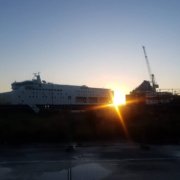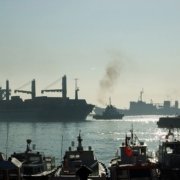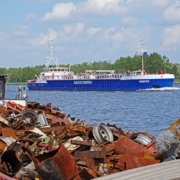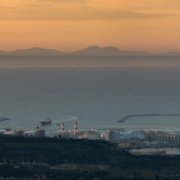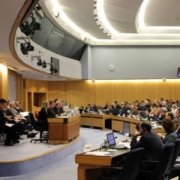Green hydrogen ‘comes back to the future’
Green hydrogen as a source of fuel can be essential for decarbonizing the transport sector, especially for covering the limitations of electric solutions and other clean energies, since it is found easily and thanks to the increase of research projects worldwide, green H is getting cheaper.

What is ‘Green Hydrogen’?
Green Hydrogen is a source of energy that has no colour, no odour or taste, is abundant and it does not emit any carbon dioxide emissions when used to power fuel cells.
There are different types of hydrogen and every type has its characteristics; they’re essentially colour codes, used within the energy industry to mark each type of hydrogen.It can be grey, blue, green, brown and even yellow and pink, depending on the type of products used, different colours are assigned to the hydrogen.
As the iconic movie trilogy of the mid-’80s “Back to the future” predicted, we can say that hydrogen “comes back to the future”.
Many factors make this raw material so appealing as a great alternative in comparison to electric and carbon fuels. And especially, now is the time to incentivise green fuels as the need for decarbonising the planet is one of the goals that countries around the world have set for 2050, especially the European Union.
How does Green Hydrogen work?
As explained before, hydrogen has no colour, but the name of the colour is given by the type of waste in the production process. Grey and blue come from fossil fuels that generate CO2, and the resulting emissions are captured, stored and not released into the atmosphere. Pink hydrogen comes through electrolysis powered by nuclear energy, yellow is a relatively new phrase for hydrogen made through electrolysis using solar power. Brown hydrogen is made using black coal or lignite (brown coal), these black and brown hydrogen are the opposite of green hydrogen in the hydrogen spectrum and the most environmentally damaging – whereas green hydrogen does not generate any emission neither in the production process nor the combustion.
Green Hydrogen is produced with no harmful greenhouse gas emissions and is generated by using clean electricity from surplus renewable energy sources, such as solar or wind power, to electrolyse water. Electrolysers use an electrochemical reaction to split water into its components of hydrogen and oxygen, emitting zero-carbon dioxide in the process, according to National Grid information.
How can the transport sector make use of green hydrogen?
Since the transport sector represents the source of one-third of total CO2 emissions in Europe, it could benefit from the renewed attention on hydrogen to replace fossil fuels and meet the European Union decarbonisation goals. This way it could be a lead actor in the transport sector where batteries are an impracticable solution to substitute fossil fuels powering ferries, coasting trade or inland waterways and in rail applications.
Currently, the production of green hydrogen represents a small percentage of the overall, this is due to the elevated costs of production. Green hydrogen will come down in price as it becomes more common, providing an answer to one of the great challenges facing the energy sector. Developing systems to store surplus energy from renewables on a large scale, reduce Europe’s energy dependence, and cover gap areas since electric energy cannot be used in all transport systems as in maritime transport.
What are the obstacles to using green hydrogen?
So, can green hydrogen be implemented right away in the transportation sector? One of the biggest barriers to the adoption of this fuel for the transport sector comes from the low supply, since FC vehicles are expensive, although mass-production could reduce costs, as well as the difficulties of mass market diffusion in hydrogen storage. If applied in the current scenario of mass production vehicles for transport and fuels, hydrogen could reach areas where batteries and electric energy sources cannot cover.
Application in maritime transport
One of the major consumers of oil products and heavy fuels is the maritime sector, harming the quality of air, especially around ports. If applied to the engines of the maritime transport sector, green hydrogen could reduce not only emissions during sea navigation, but also those deriving from port operations.
In the last year, there have been some steps towards creating the world’s first hydrogen-powered cargo ship. Implementing this technology on ships, ferries and other coastal crafts could strongly reduce CO2 emissions.
Application in rail transport
Currently, it is difficult to electrify certain sections of railway lines on which fossil fuel-powered trains are used. Hydrogen trains are considered competitive for those railway sections that don’t depend on electric energy, with a low frequency of service and operate on long distances. These conditions are frequent in rail transport, making hydrogen rail mobility interesting from an economic point of view and an excellent opportunity to further decarbonise public transport, according to Enea, (Agenzia nazionale per le nuove tecnologie, l’energia e lo sviluppo economico sostenibile).
Certainly, we will see green hydrogen powering sectors that strongly depend on carbon fuels as companies and countries meet the goals for reducing carbon dioxide emissions, especially in the maritime and rail transport sectors. This is without a doubt a comeback to clean and essential sources of energy and as the famous DeLorean from the film, engines will be using clean hydrogen to keep up the pace.
Sources:
The hydrogen colour spectrum | National Grid Group
Hydrogen and “green transport” – EAI (enea.it)
Green Hydrogen: an essential element for decarbonization (cepsa.com)
Alternative Fuels Data Center: Hydrogen Benefits and Considerations (energy.gov)


